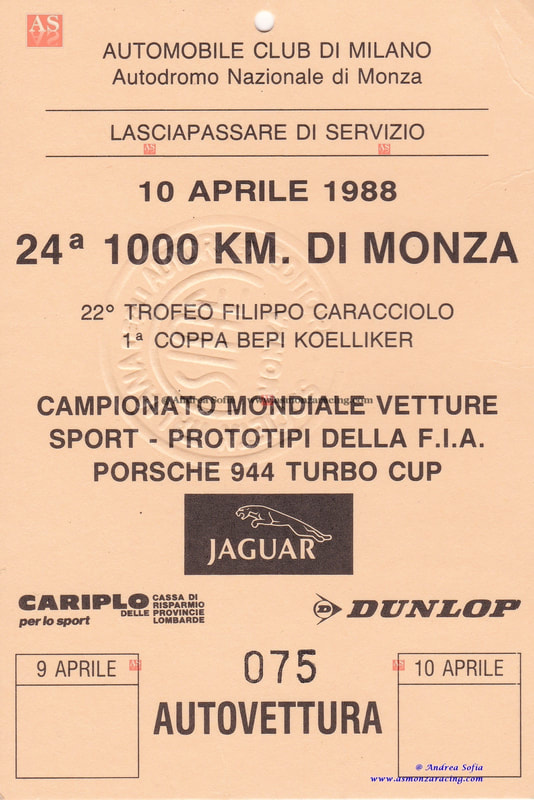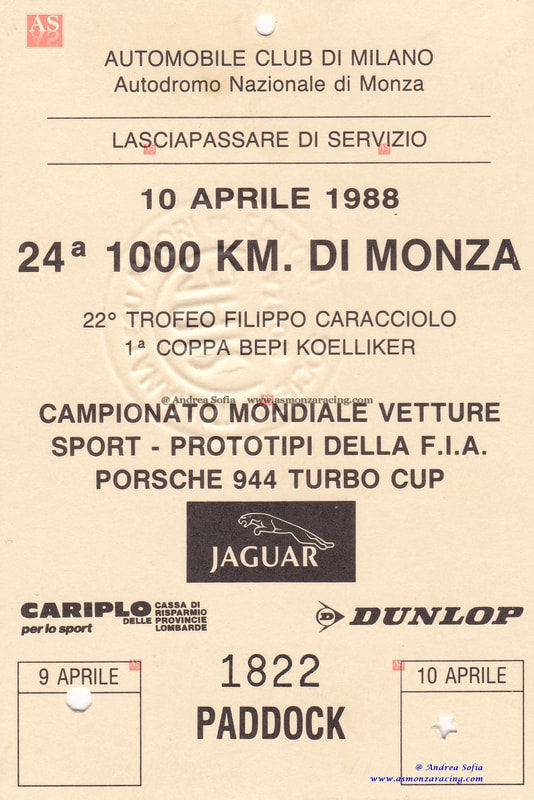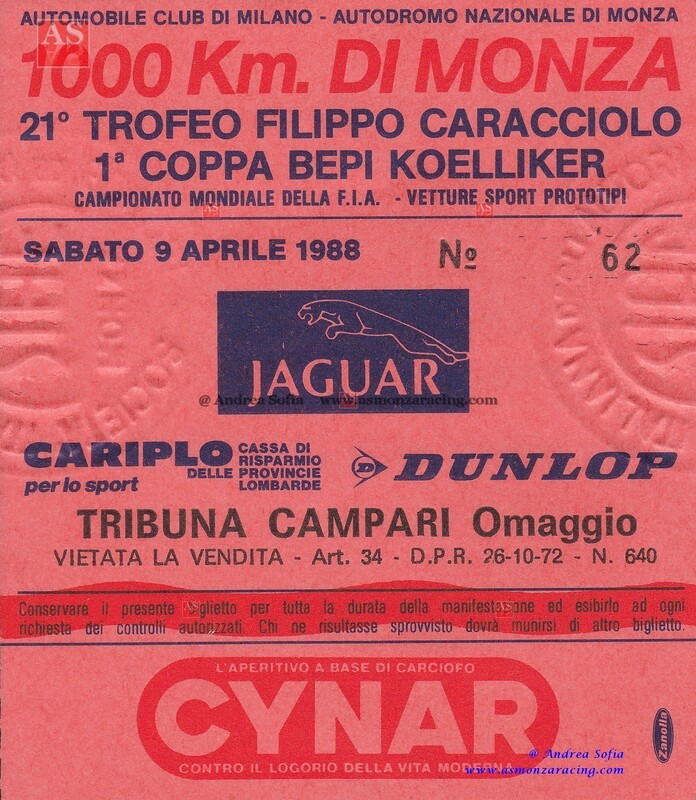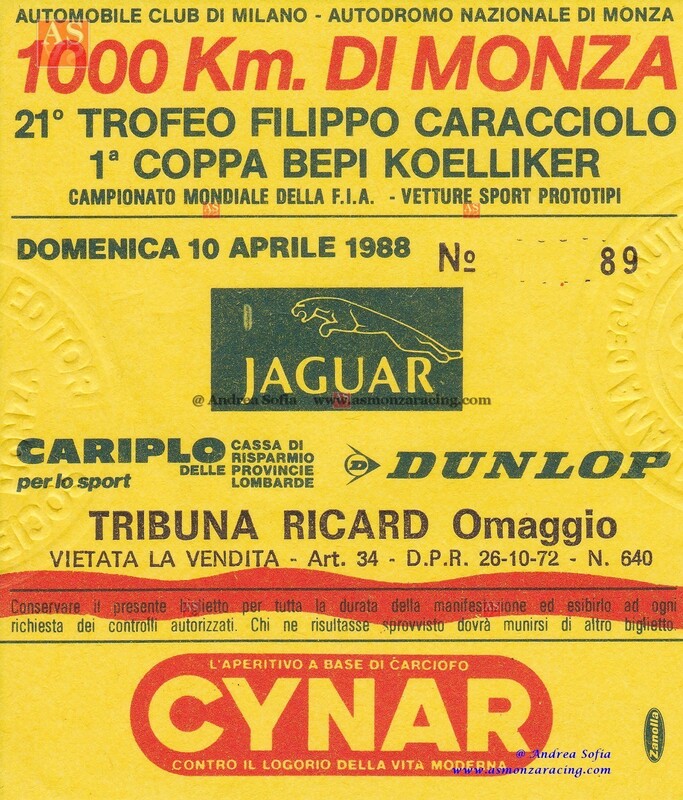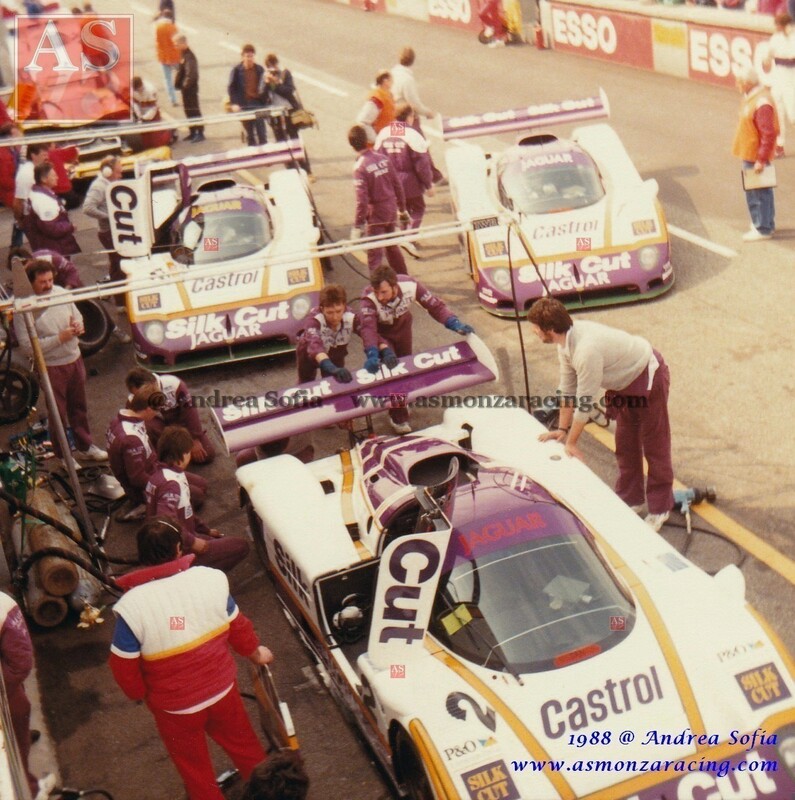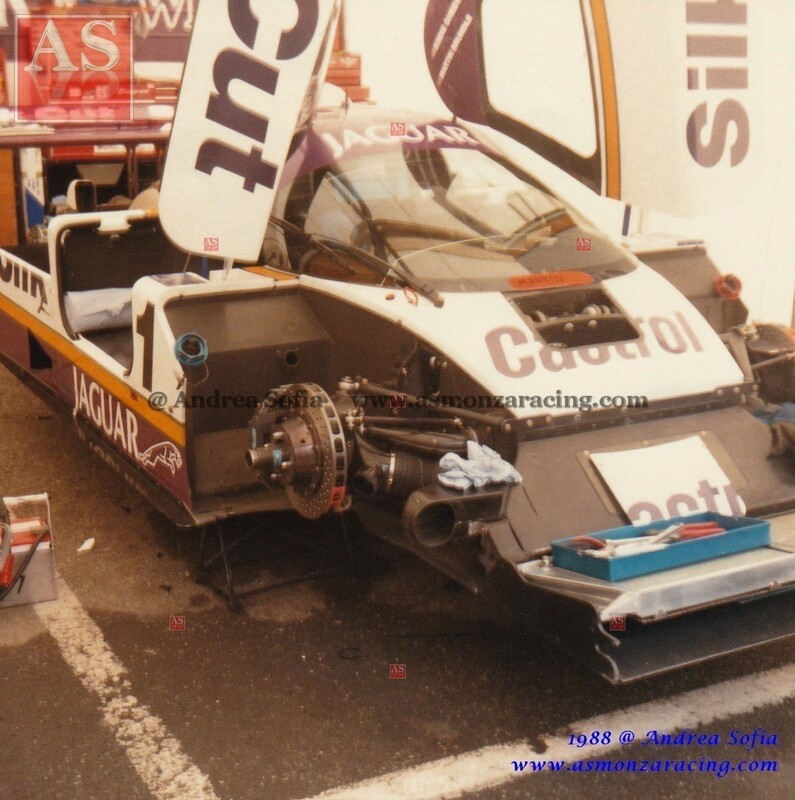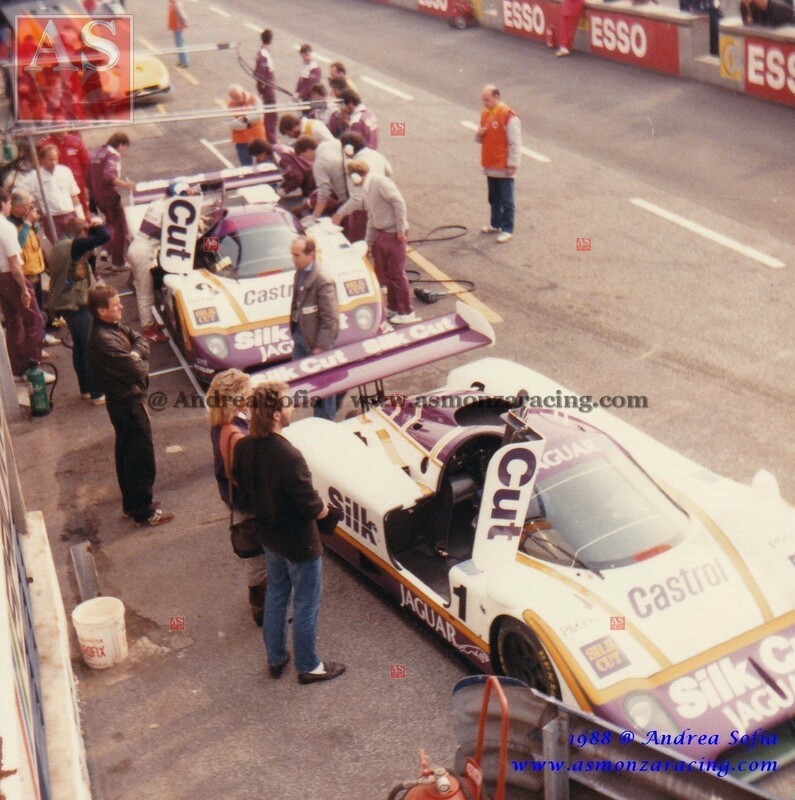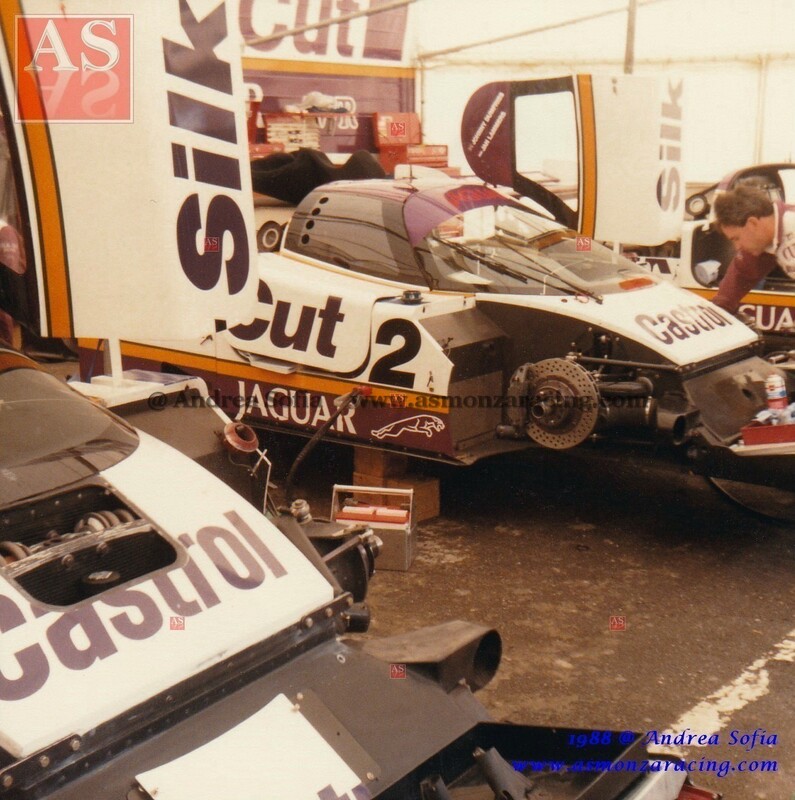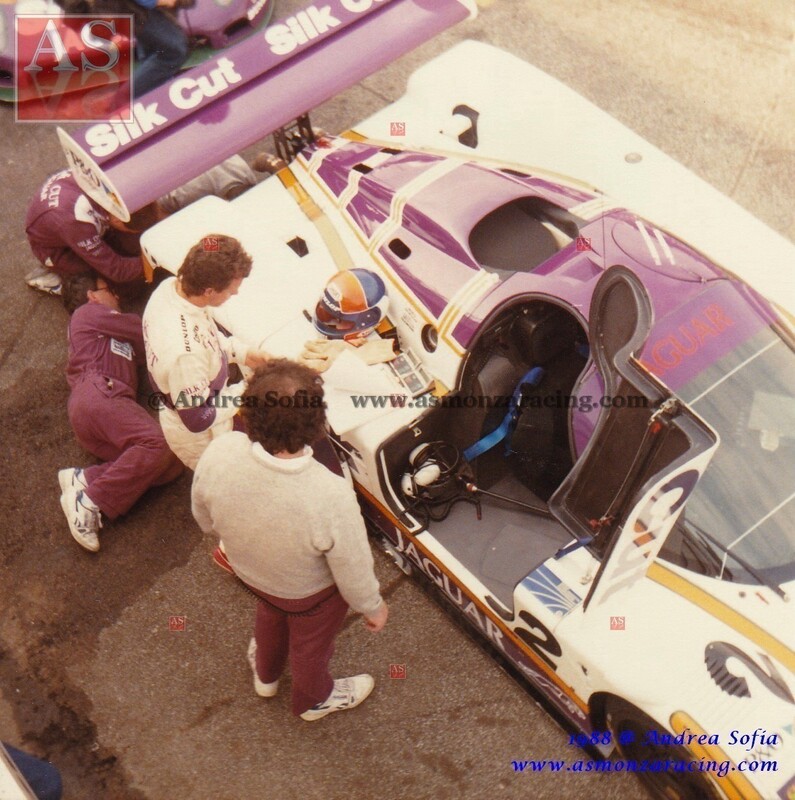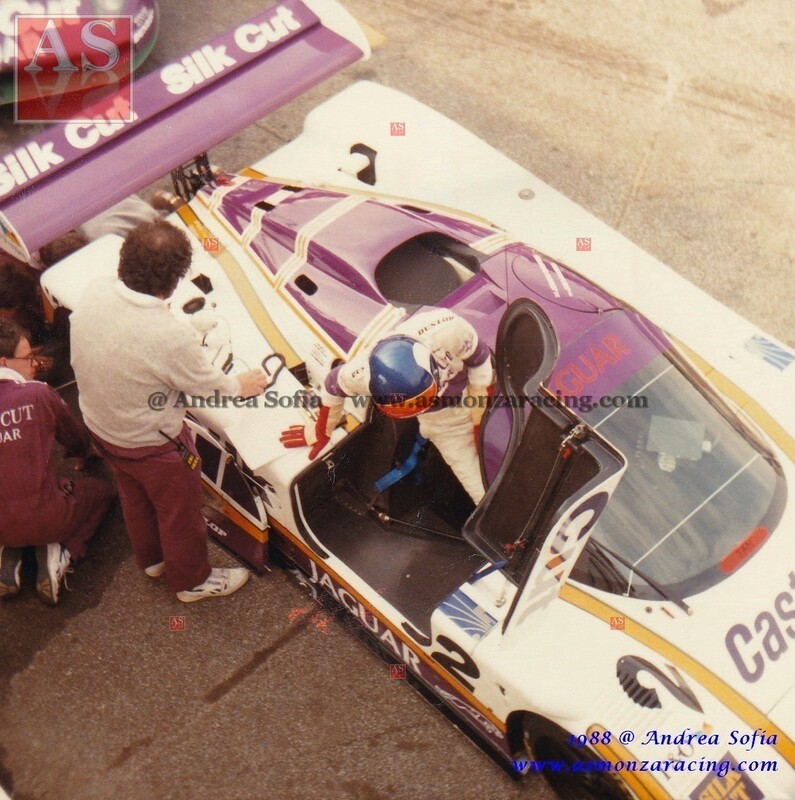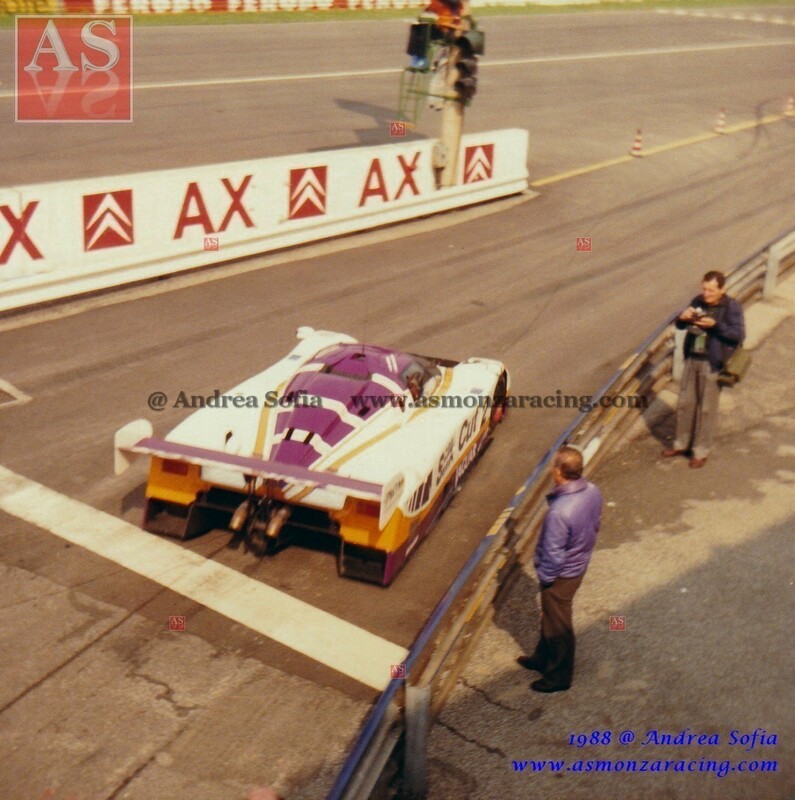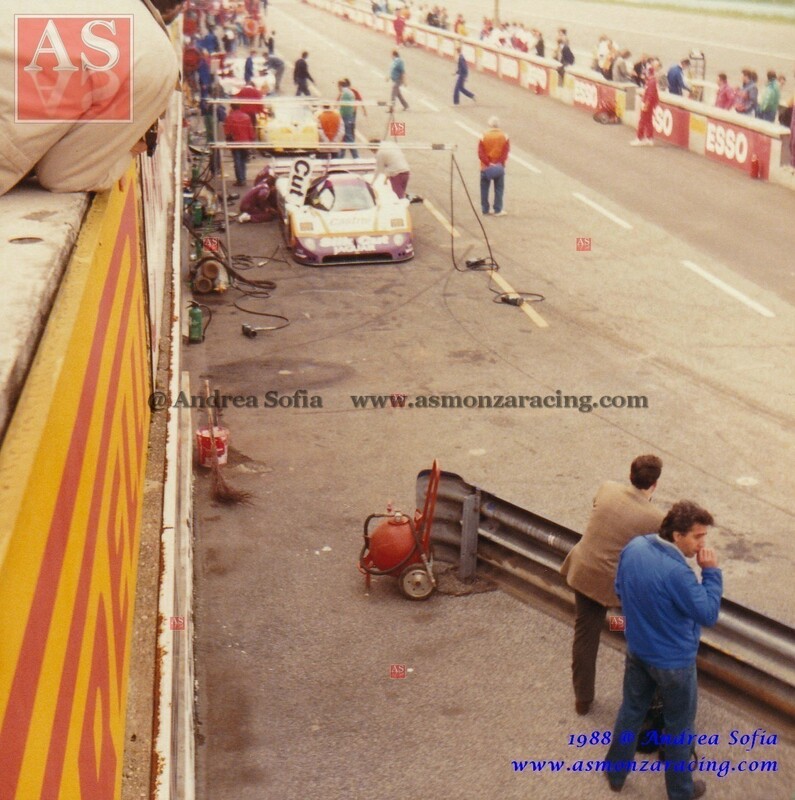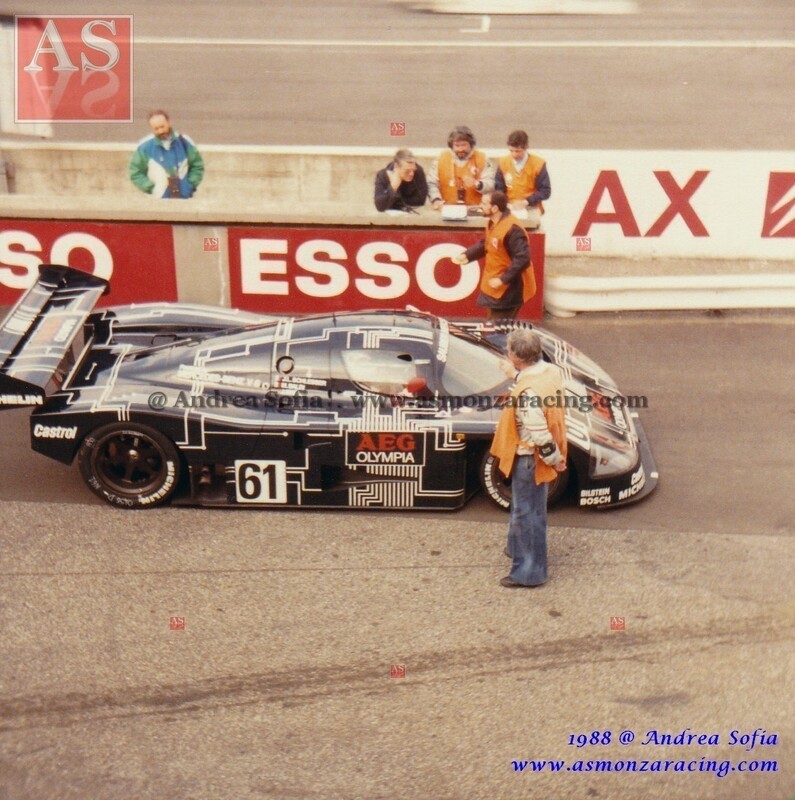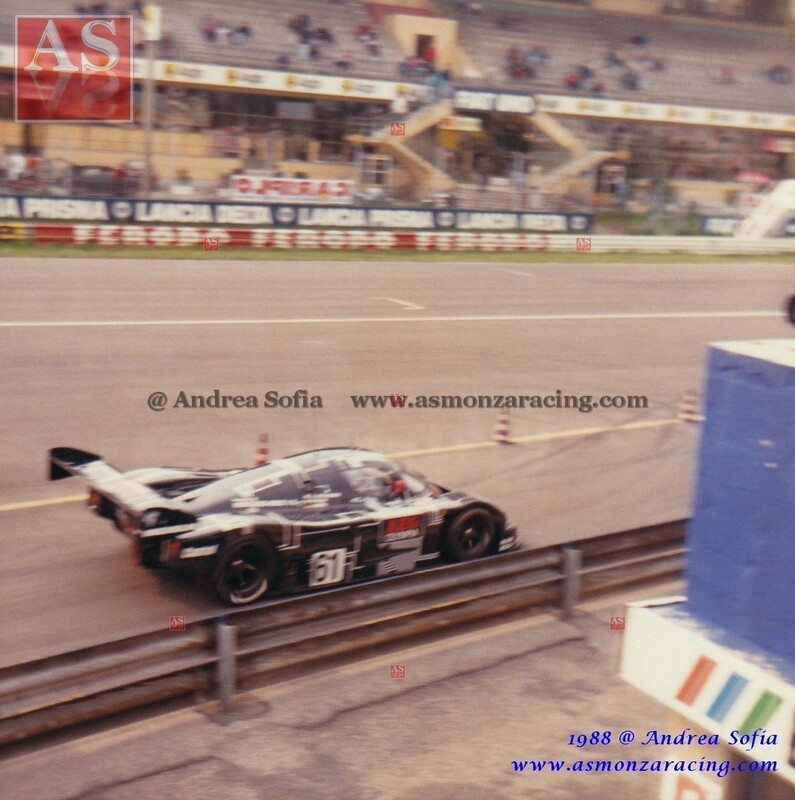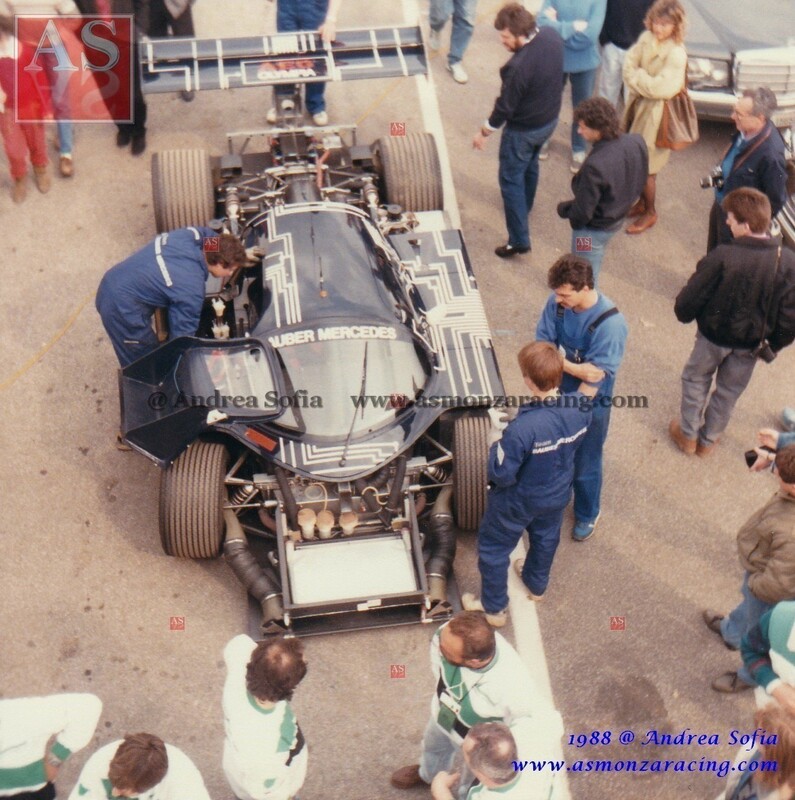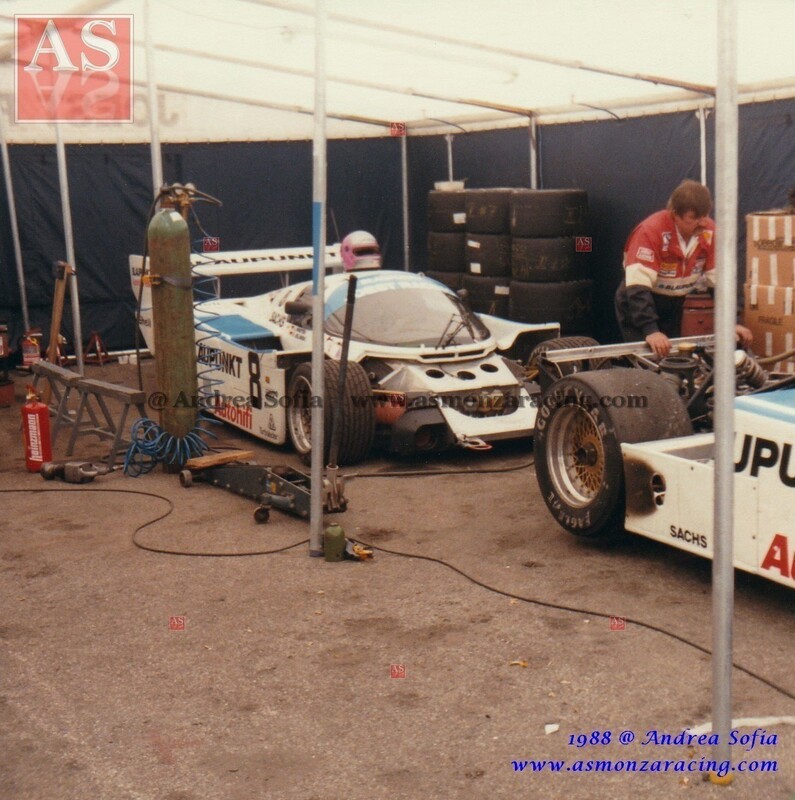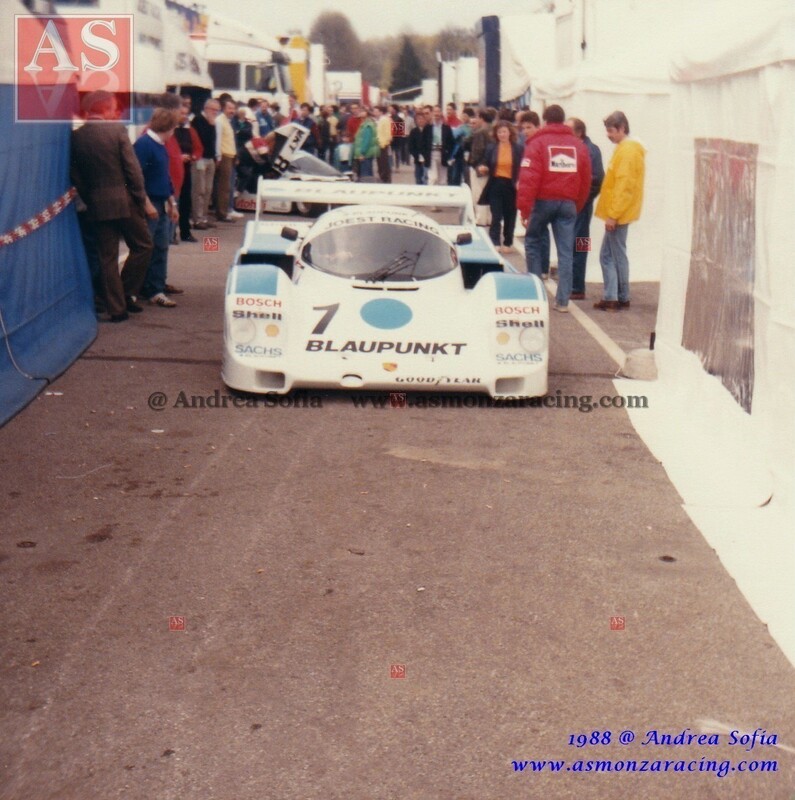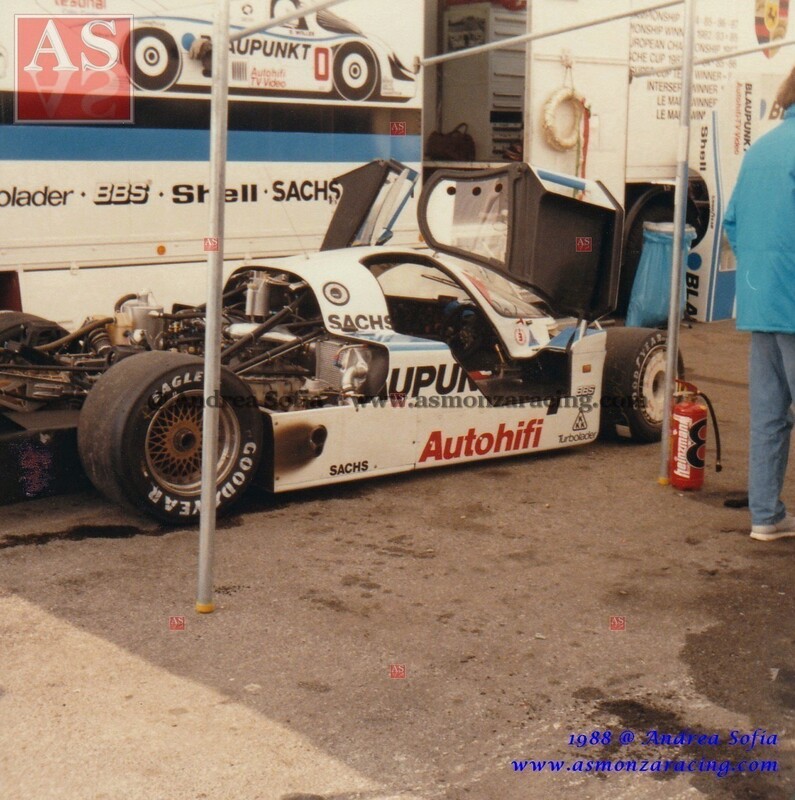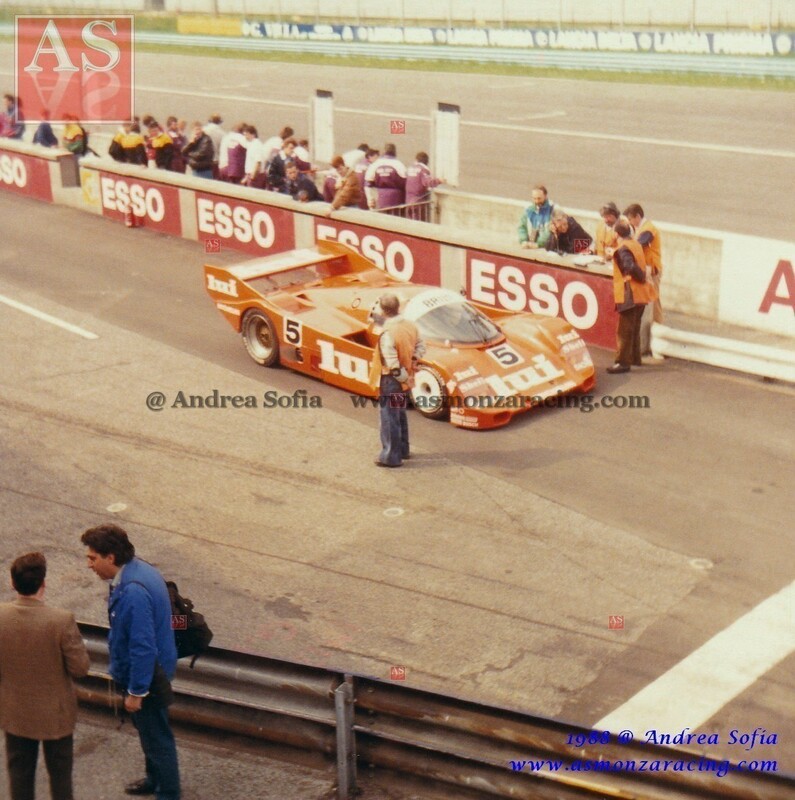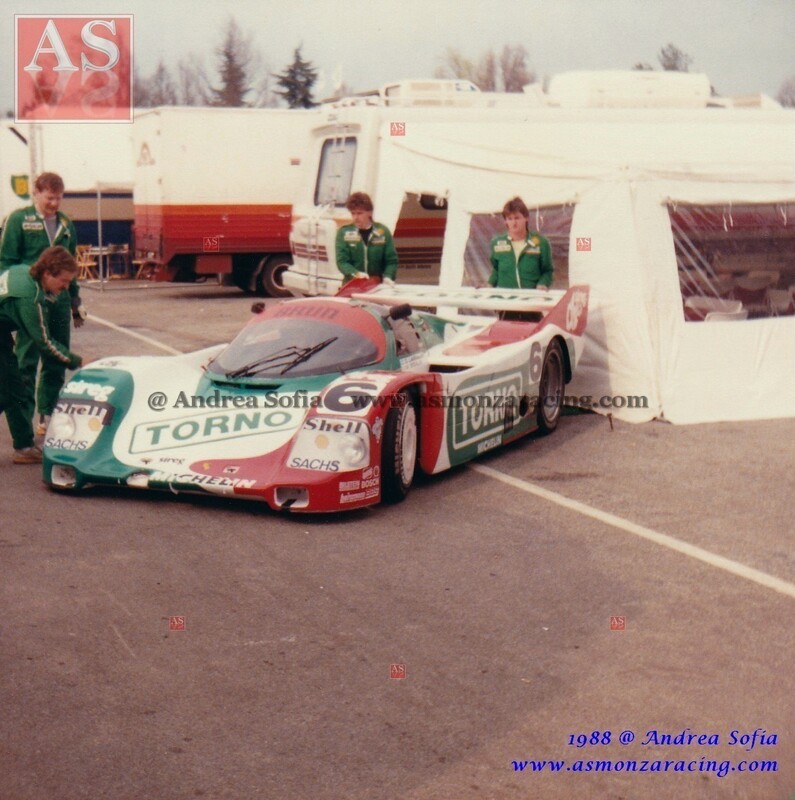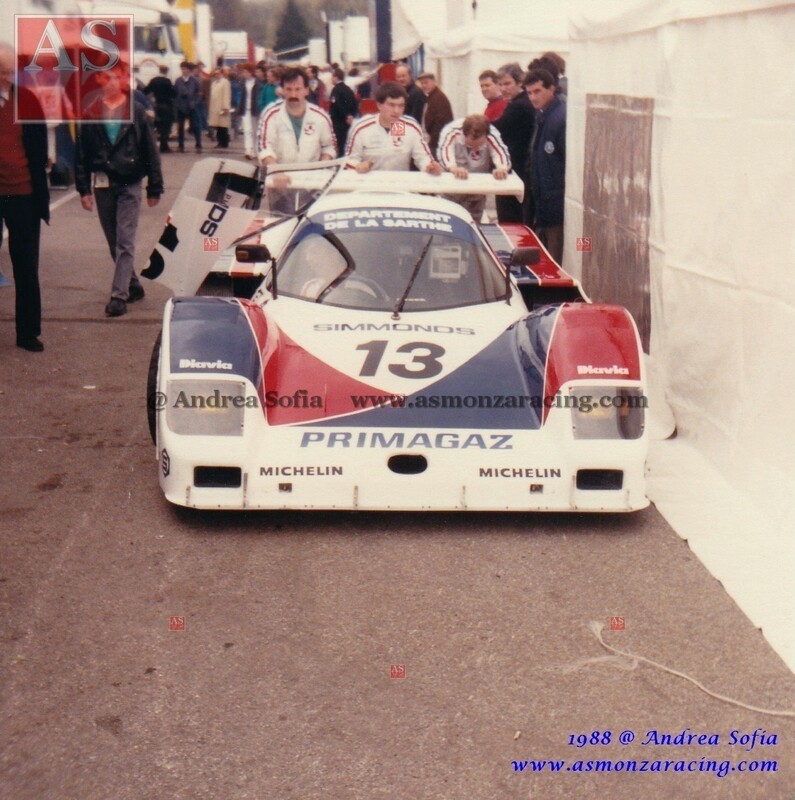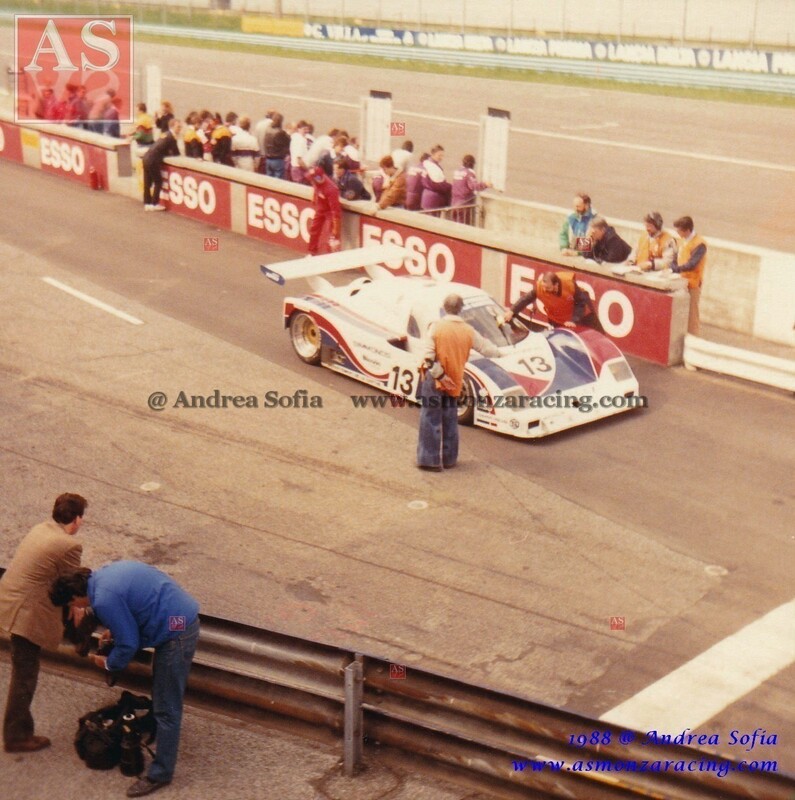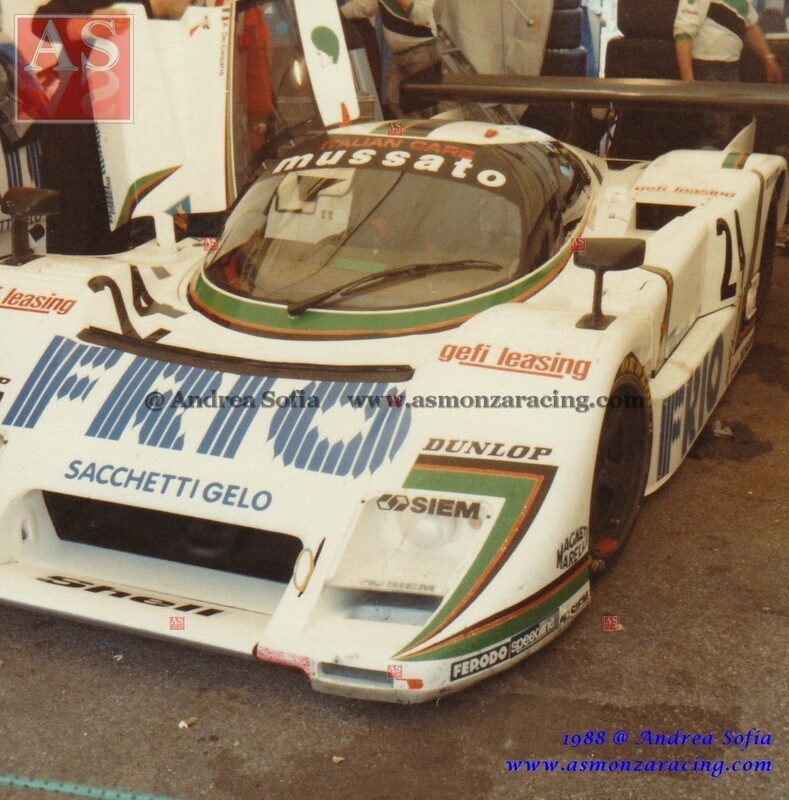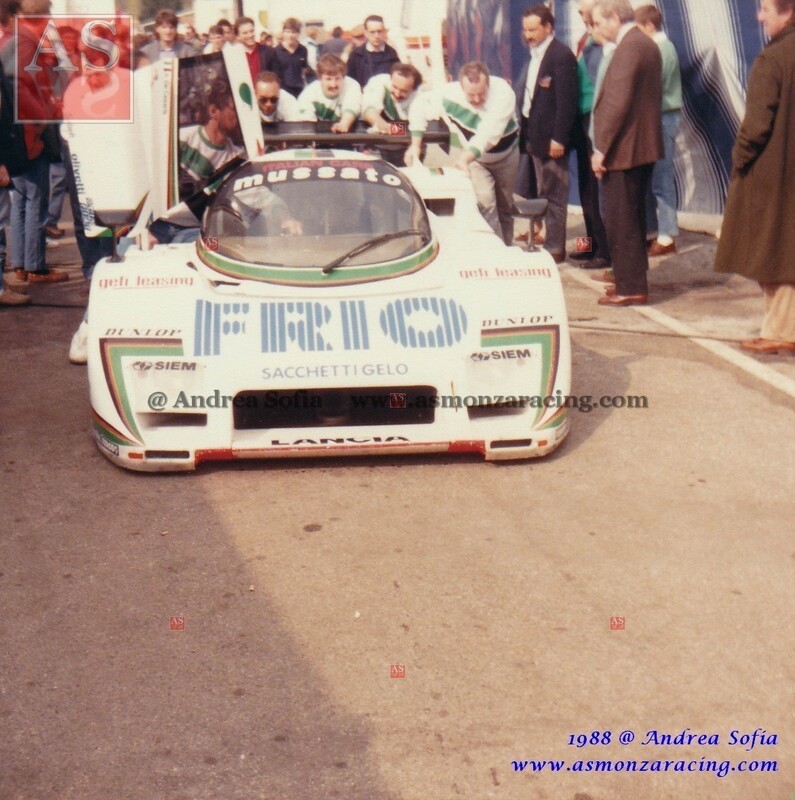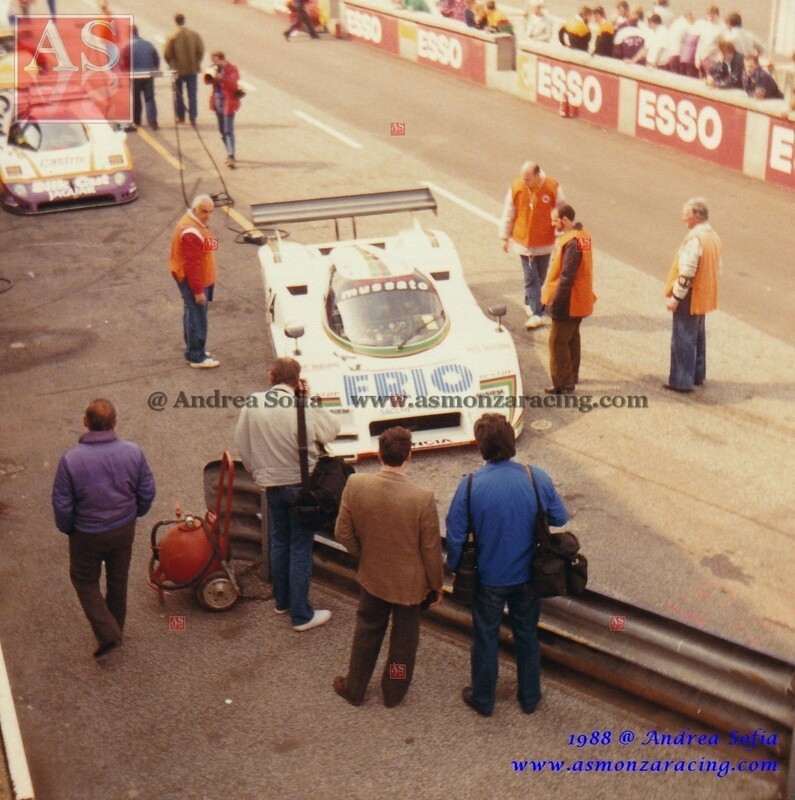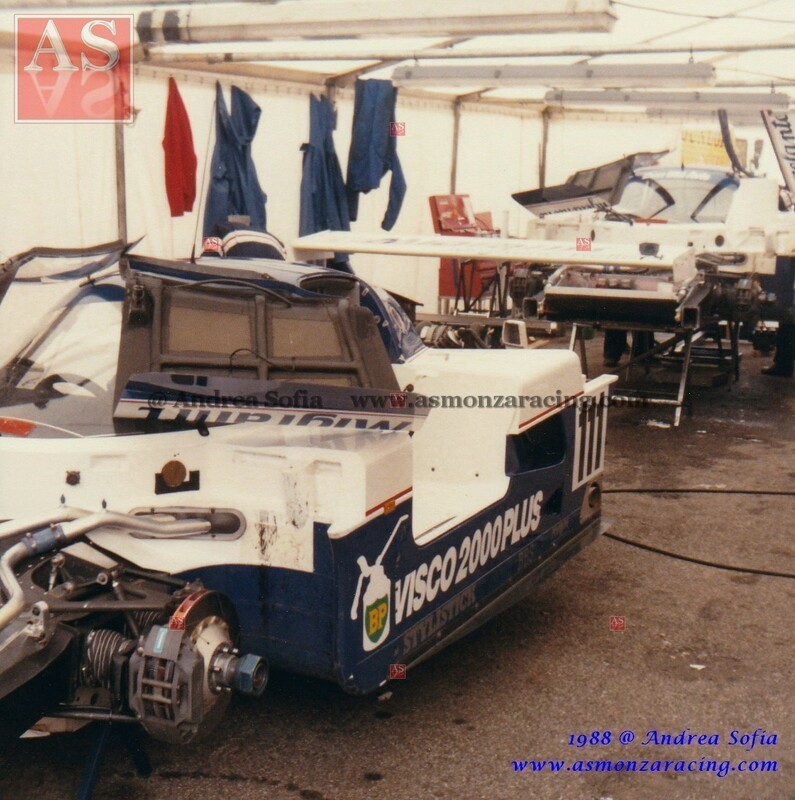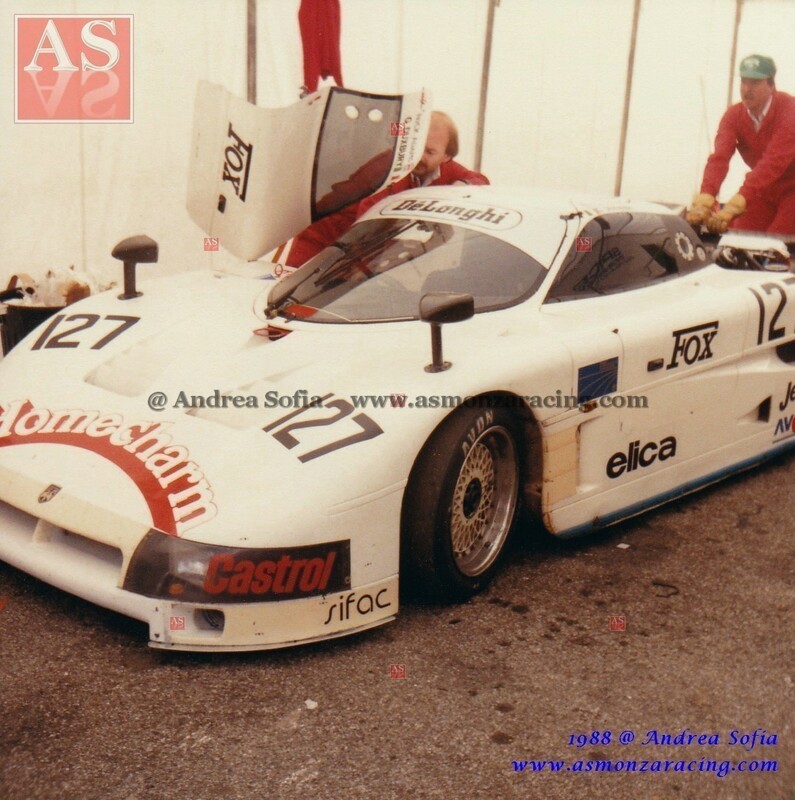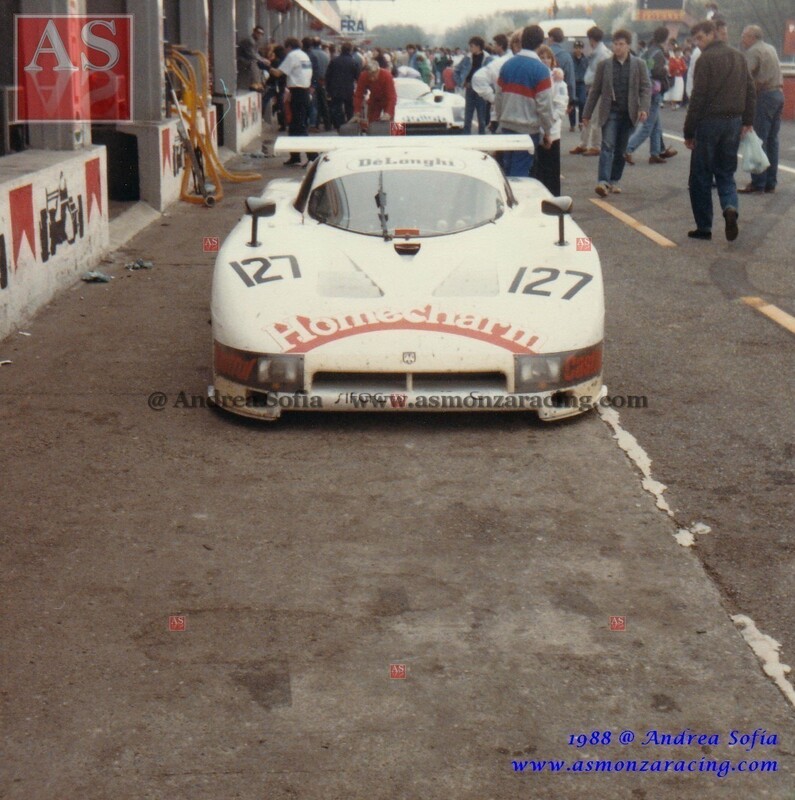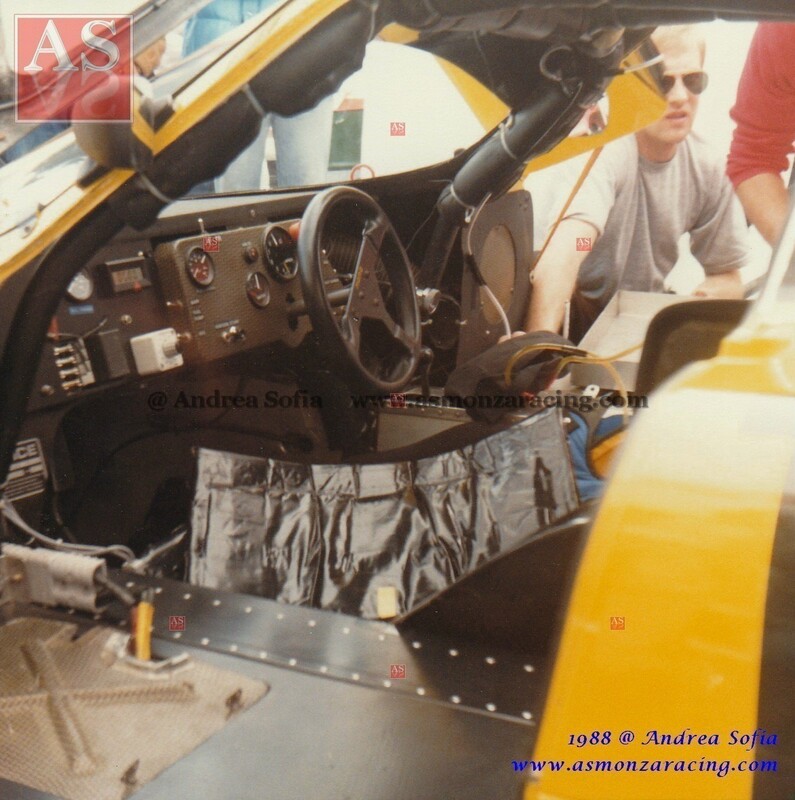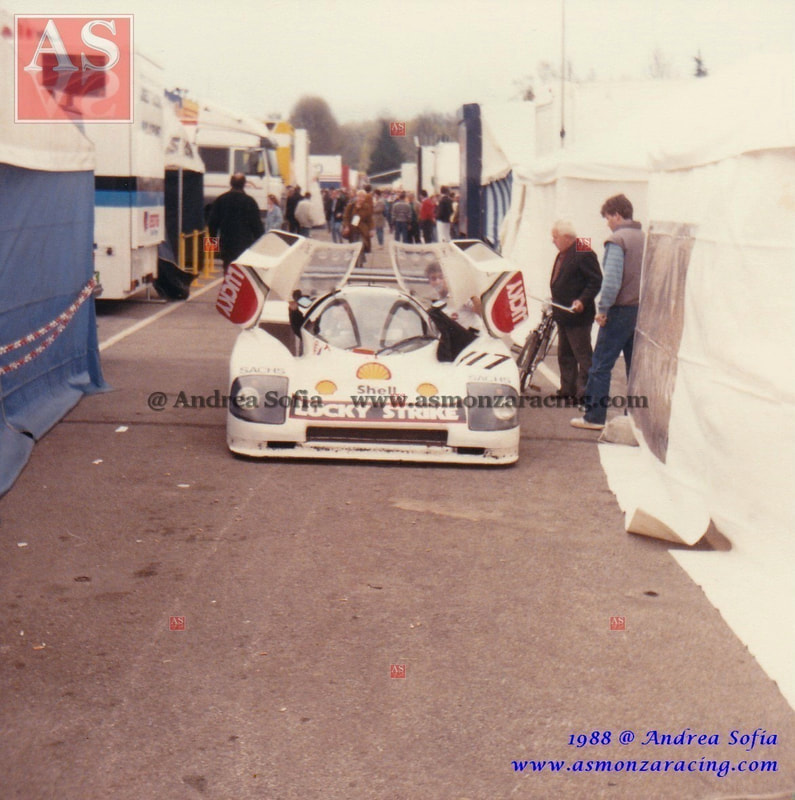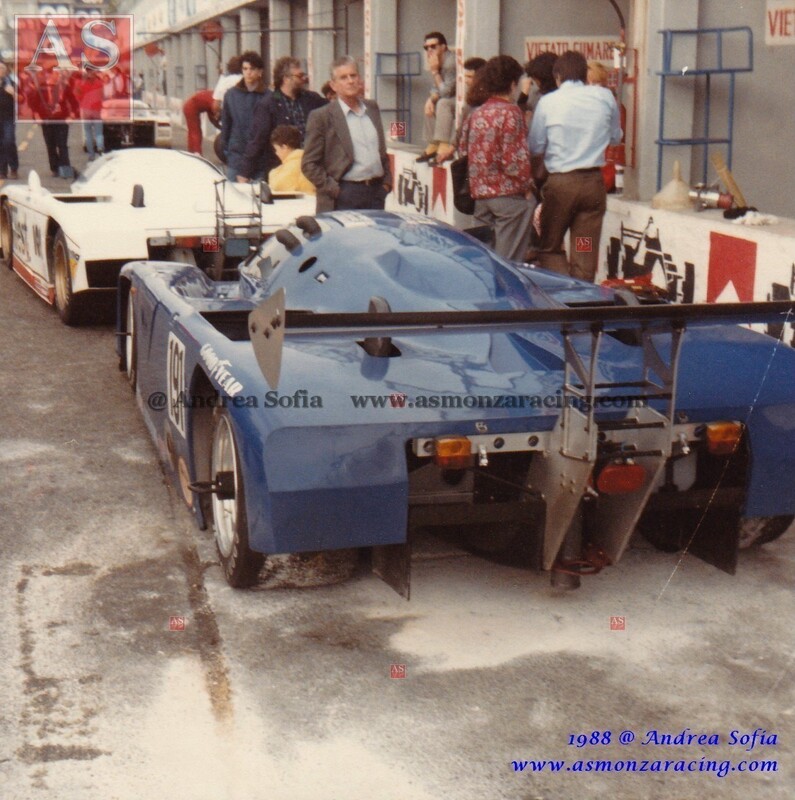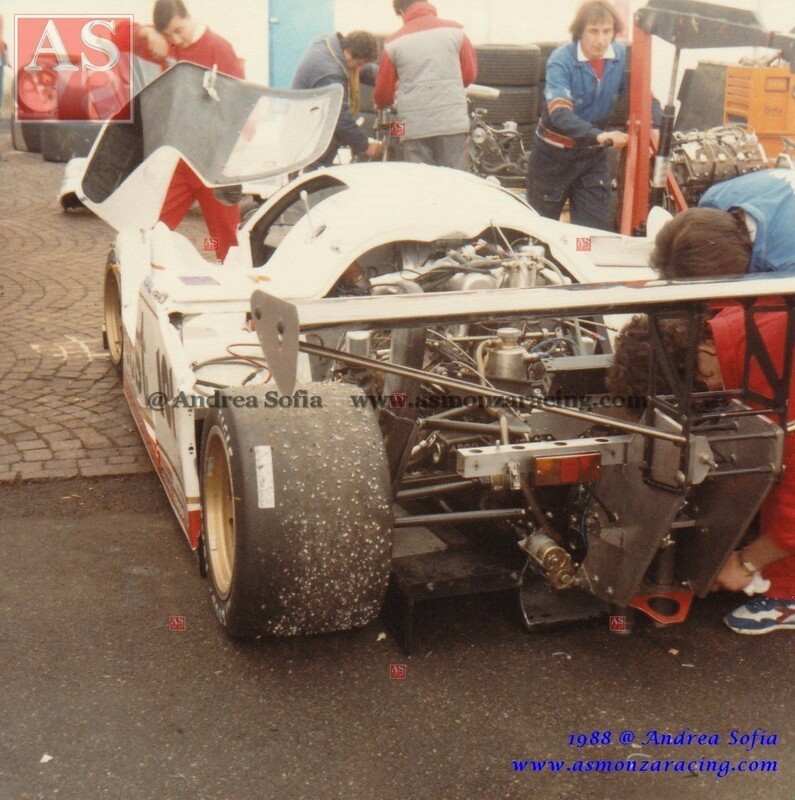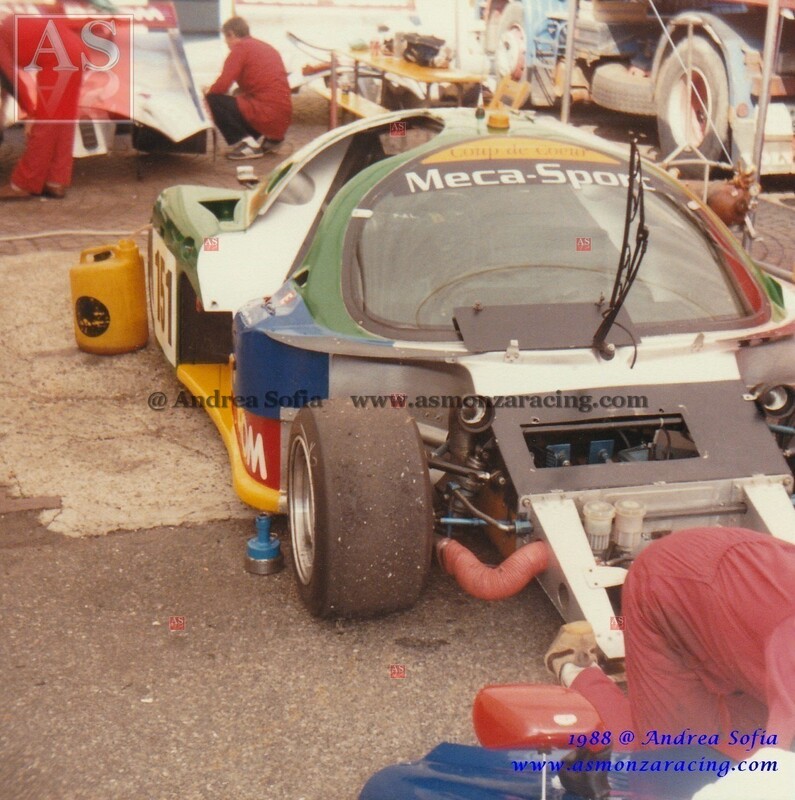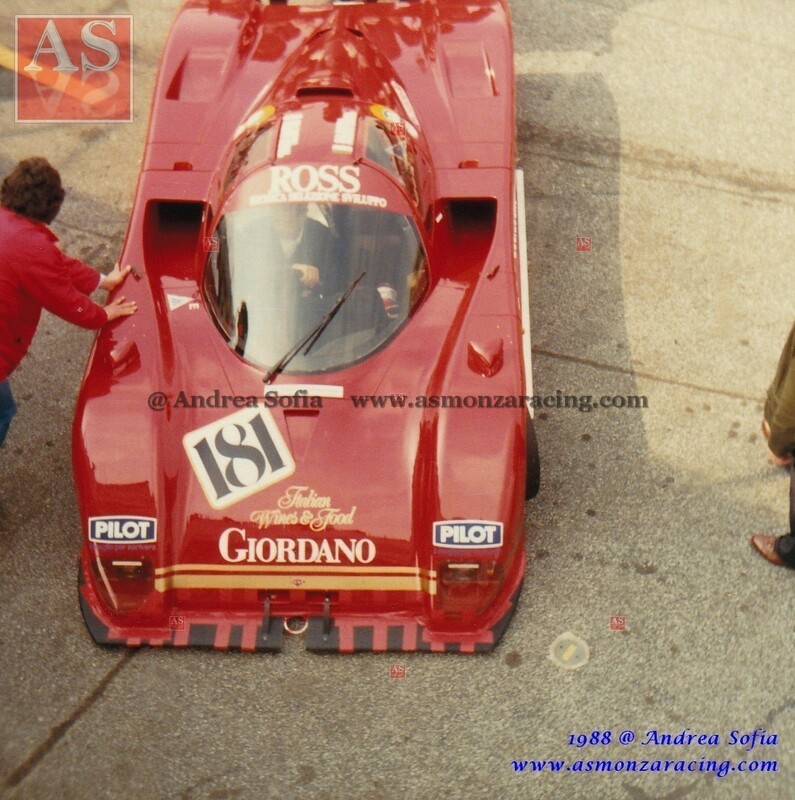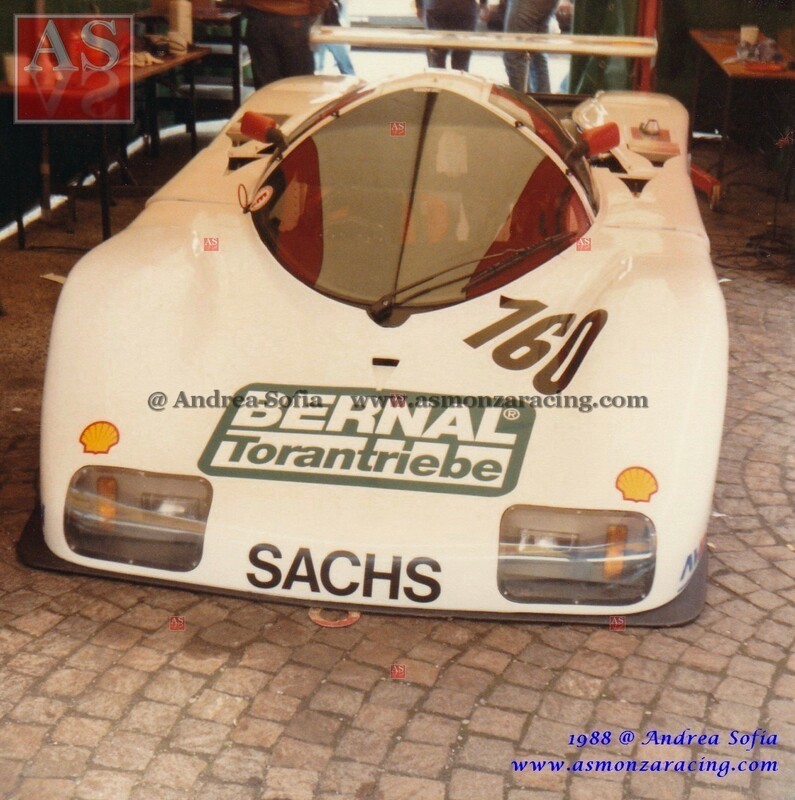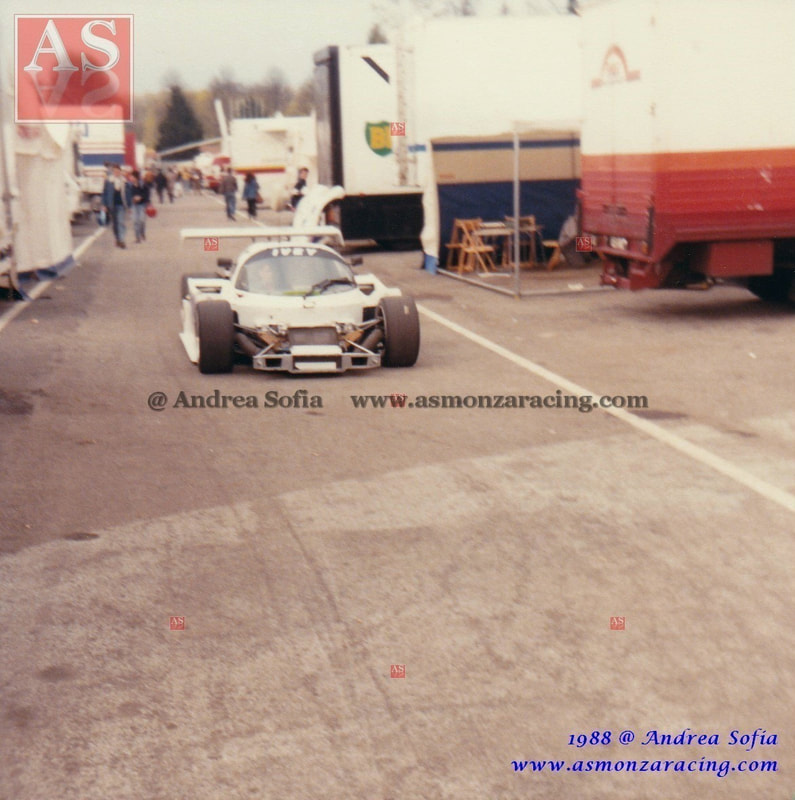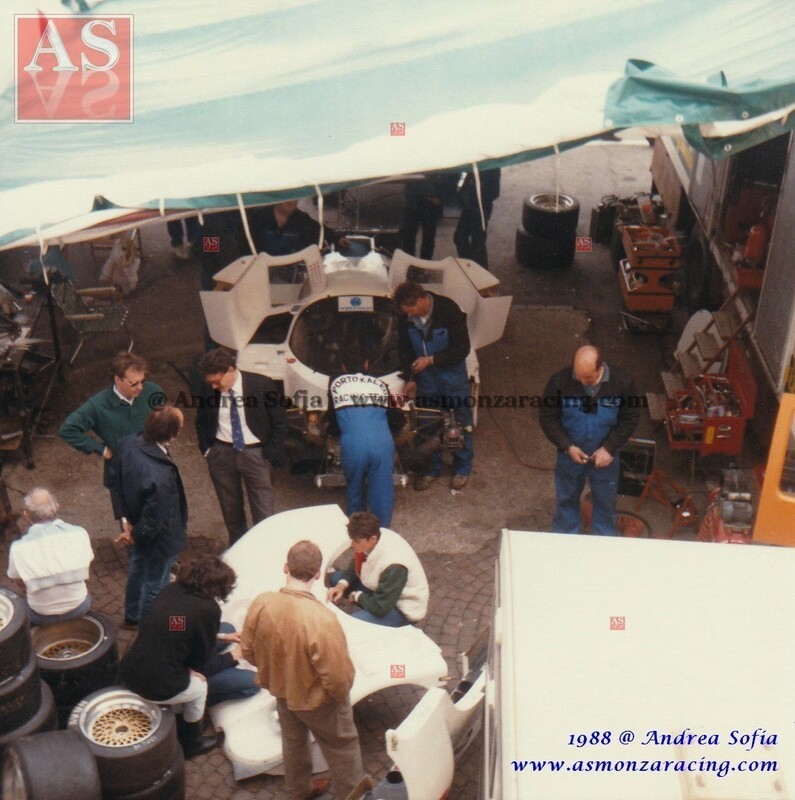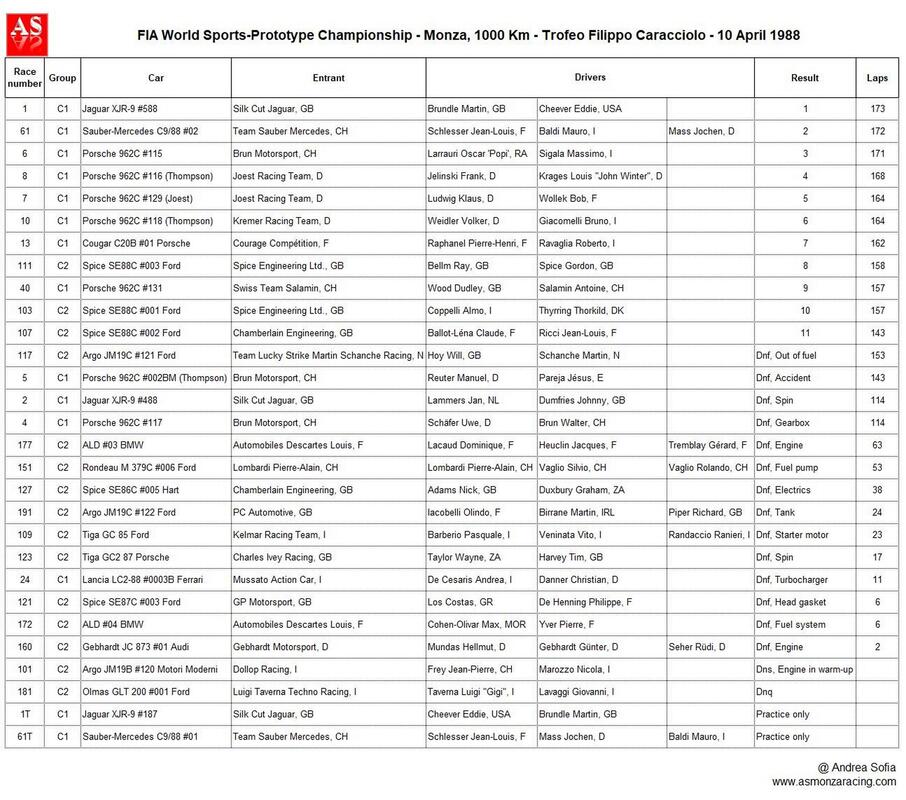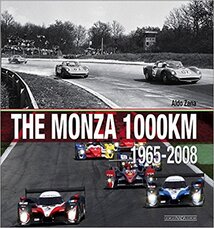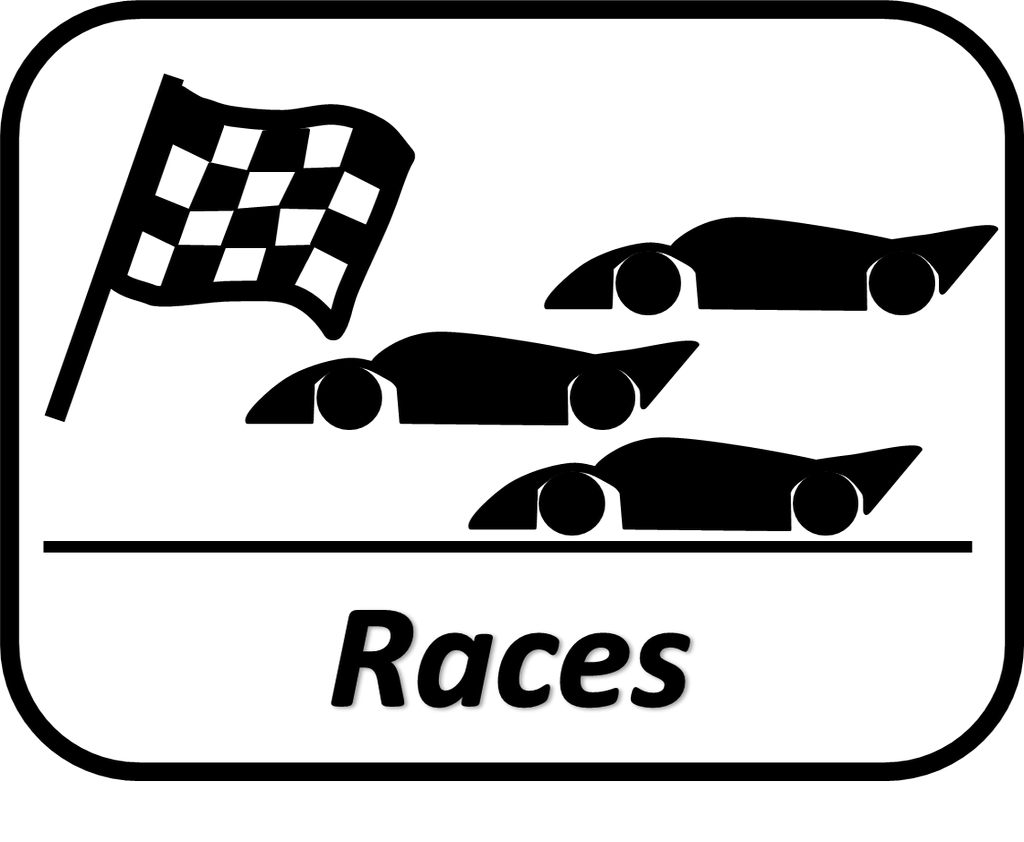1000 Km of Monza 8-9-10 April 1988 Trophy "Filippo Caracciolo"
The 1000 km of Monza in 1988 was the third race of the FIA World Sports-Prototype Championship, after the two races held in Spain, the 800 km of Jerez and the 360 km of Jarama. The championship standings, on the eve of the Monza race saw Sauber-Mercedes in the lead followed by the Jaguar and the Porsche of Team Joest. The field of entered at the 1000 km of "Brianza" was very respectable. In total 14 C1 cars, including two T-Cars, represented by Jaguar, Sauber-Mercedes, Porsche, Cougar and 15 C2 represented by 6 different manufacturers, Spice with 5 specimens, Argo with three specimens, Tiga and ALD with two and Gebhardt, Rondeau and Olmas with a car each one. For the large C1 cars, the rules provided for a minimum weight of 800 kg and no more than 510 litres of fuel available for the 1000 km race, while for the C2 class the minimum weight was 700 kg and the maximum quantity of fuel to be used for 1000 km fixed at 363 litres, 10% more than the previous year.
After the Monza's race, particularly spectacular and fought with continuous changes in front, despite the rules regarding fuel consumption, the Silk Cut Team Jaguar came out victorious for the second time in three races and found itself at the top of the championship in front of the Sauber-Mercedes.
After the Monza's race, particularly spectacular and fought with continuous changes in front, despite the rules regarding fuel consumption, the Silk Cut Team Jaguar came out victorious for the second time in three races and found itself at the top of the championship in front of the Sauber-Mercedes.
TWR Jaguar XJR-9
Tom Walkinshaw's TWR Team, back from the victory in the second race of the World Championship at Jarama, brought three Jaguars XJR-9 to Monza, the third scheduled race. The cars, built by Tom Walkinshaw Racing in Kidlington, Oxfordshire in collaboration with Jaguar, were the evolution of the previous year's XJR-8 model and were fitted with a monocoque made of carbon fibre and kevlar, and equipped with a 6125 cc V12 engine capable of delivering nearly 760 hp. The crews consisted of Martin Brundle / Eddie Cheever who used the chassis TWR-J12C-588 and Jan Lammers / Johnny Dumfries who were given the chassis TWR-J12C-488. The third car, the chassis TWR-J12C-187 was used only in practices. At the end of the qualifying, the Jaguars were given the same time, 1: 33.62, which earned the two crews Brundle-Cheever and Lammers-Dumfries the fourth and fifth positions respectively on the starting grid.
Jaguar XJR-9 chassis #TWR-J12C-588
The Anglo-American crew's race with the car marked by the number 1 was a true masterpiece that took them to the top step of the podium. With an extremely regular race conduct, Martin Brundle and Eddie Cheever bent the fierce competition of Sauber-Mercedes and Porsche without having problems with fuel consumption.
Jaguar XJR-9 chassis #TWR-J12C-488
At the start of the launch lap, the Lammers-Dumfries engine did not want to fire up and the car was started pushing by mechanics so, at the start of the race it was at the bottom of the grid. On lap 20 Lammers was already fifth but on lap 78, at the Roggia chicane he entered hard on Baldi hitting him on the side-pod. The Dutch driver was forced to stop in the pits losing 5 laps to replace the damaged radiator in the impact. Dumfries started from the pit trying to force the gap only to finish on lap 114 spinning at the Ascari chicane.
Sauber C9-88 Mercedes chassis #87-C9-02
Although the Sauber C9-88 had an aluminium monocoque, lesser than the carbon fibre jaguar's chassis, it was powered by the Mercedes M117 4973 cc V8 engine tuned by the Swiss specialist Mader, supercharged with two KKK devices that allowed to develop a power close to 800 hp, in qualifying configuration. At Monza the Team Sauber-Mercedes brought two cars, the chassis C9-88-02 as a race car and the chassis C9-88-01 as a T-Car. The team's only crew consisted of Jean-Louis Schlesser, Mauro Baldi and Jochen Mass, already winners of the first championship race at Jerez. At the end of qualification days they were the fastest, scoring pole position at 1: 31.69 and after a hard-fought race, they took second place despite the accident with Lammers at the Roggia chicane and some consumption troubles.
Porsche 962C
No longer technically in step with Jaguar and Sauber-Mercedes, Porsche was present at Monza with 6 cars, all managed by private teams, 3 cars managed by Team Brun, 2 by Team Joest, one for Team Kremer, entered for Wolker Weidler and Bruno Giacomelli and one for the very private Swiss Team Salamin for the drivers Dudley Wood and Antoine Salamin himself. In the end the Stuttgart home achieved an honourable result by winning the lowest step of the podium with the Team Brun's car driven by Massimo Sigala and Oscar Larrauri.
Team Joest - Porsche 962C chassis #116 (8) e chassis #129 (7)
Team Joest in the colours of the Blaupunkt, lined up chassis # 129, built by Joest, for Klaus Ludwig and Bob Wollek with the number 7 and the chassis #116, built by Thompson for Frank Jelinski and "John Winter", whose real name was Louis Krages, with the number 8. Wollek and Ludwig in practices were very fast, proving that even if obsolete, in the expert hands the 962C could still prove something. In the race they were among the absolute protagonists, not caring about fuel consumption but in the end they had to stay in the pits for six laps with the tank almost dry, finishing the race in fifth place. Quiet and profitable race for the duo "Jelinski-Winter", fourth at the finish line after starting from the eighth position on the grid.
Team Brun - Porsche 962C chassis #115 (6) e chassis #002BM (5)
Team Brun brought three Porsche 962Cs: Chassis #115 for Massimo Sigala and Oscar Larrauri, Chassis #117 for Uwe Schäfer and Walter Brun himself and chassis #002BM, build in carbon fibre by Thompson, for Manuel Reuter and Jésus Pareja. With a smart and careful race, the top crew composed by Sigala and Larrauri finished third after having obtained the third fastest time on practices, while the Reuter-Pareja crew, seventh at the start, finished the race on lap 144 destroying the car against the barriers of the second Lesmo corner and also involving the car of Sigala-Larrauri that after a stop for the replacement of a wheel managed to continue. Colourless instead the race of the Porsche 962C driven by Schäfer-Brun, stopped at the 114th lap with the broken gearbox.
Cougar C20B Porsche chassis #01
The Cougar C20, built by the French team Courage Competition, was equipped with the 6-cylinder Porsche Type-935 turbo and was making its debut at Monza. Roberto Ravaglia and Pierre-Henry Raphanel obtained the seventh final place at 11 laps from the winners, after starting from the thirteenth position. The second and last race of the Cougar C20 in 1988 was the Le Mans 24 hours.
Lancia LC2/88 Ferrari chassis #0003B Scuderia Mussato Action Car
In 1986 Luigi Mussato had taken over all the material of the Lancia group C and after the catastrophic accident of Bruno Giacomelli at Zeltweg during the tests of the Interserie race where driver was seriously injured and the Lancia LC2 / 85 #0003 was destroyed, the 1988 was due be the year of the relaunch for the small and organized Scuderia Mussato Action Car. Two new monocoque were made by Dallara on Lancia specifications and updated to the new regulations, the suspensions were redesigned, the front section was reduced, the Ferrari V8 turbo engine remained unchanged but was moved more to the centre and also the body was re-built using carbon fibre. The Lancia LC2 turned out to be a completely new car and the debut took place at the 1988 Monza 1000 km driven by Andrea De Cesaris and Christian Danner. In practices the car turned out to be rather slow and qualified in fifth row with a time of 1'38 "27. The race lasted only 11 laps then the car returned to the pits with a broken turbine.
Spice SE88C Ford Cosworth DFL chassis #003 (111) Spice Engineering
|
The works Team Spice Engineering participated in the world prototype sports championship with the new Spice SE88C, equipped with a very refined aluminium chassis, the 3.3-liter Ford Cosworth DFL engine tuned by Nicholson and a much improved aerodynamic body compared to previous models. Two cars were present at Monza: The Spice SE88C, chassis #003, race number 111, driven by the owner of the Team, Gordon Spice and by Ramond Bellm who qualified with the 19th fastest time and reached the finish line eighth overall and first in group C2 and the Spice SE88C chassis #001, race number 103, driven by the Italian Almo Coppelli and the Danish Thorkild Thyrring who qualified fourteenth on the grid and finished tenths overall and seconds in group C2.
|
Spice SE86C Hart 418T chassis #005 Chamberlain Engineering
The Chamberlain Engineering Team Spice SE86C, equipped with the 4-cylinder Hart 418T turbo engine, was the fastest among the C2 group at the end of the practices. The crew, composed by the Englishman Nick Adams and the South African Graham Duxbury, started from the sixth row with the eleventh time. On lap 38 they were forced to retire due to an electrical failure.
Spice SE87C Ford Cosworth DFL chassis #003 GP Motorsport
|
The Spice SE87C managed by the British Team GP Motorsport was driven by the Greek Costas Los and the French Philippe de Henning. The car, fitted the 3.3-liter Ford Cosworth DFL engine qualified fifteenth on the grid, but on lap eight was forced to retire due to the failure of a cylinder head gasket.
|
Argo JM19C Ford Cosworth DFL chassis #121 Lucky Strike Racing
|
The Argo JM19C, chassis # 121 of Will Hoy and Martin Schanche, equipped with the classic 3.3-liter Ford Cosworth DFL and managed by Lucky Strike Martin Schanche Racing team, was the fastest of the three Argo cars at Monza. In practices the crew qualified twelfth, seconds in group C2 but in the race they remained without fuel, managing to cover 153 laps and were not classified.
|
Argo JM19C Ford Cosworth DFL chassis #122 PC Automotive
|
The Argo JM19C of the British Team PC Automotive, chassis #122 was driven by the crew composed by Olindo Iacobelli, Martin Birrane and Richard Piper and was equipped with the Ford Cosworth DFL engine. They qualified with the last time in 26th place and in the race the car was forced to retire after 24 laps for a fuel leak from the tank.
|
Argo JM19B Motori Moderni chassis #120 Dollop Team
|
The brave attempt of the Italian Team Dollop, managed by Pierluigi Corbari and Antonio Ferrari to mount the V6 Motori Moderni turbo engine on an Argo JM19B chassis was not a success. The rather fragile chassis could not uphold the power of the 6-cylinder engine realized by Carlo Chiti, which even if it had been reduced to 2 litre of displacement was able to develop 700 horsepower. At Monza the car driven by Jean-Pierre Frey and Nicola Marozzo qualified with the 16th time. During the warm-up, on Sunday morning the engine broke down and the team was unable to replace it in time, thus having to give up the race.
|
Rondeau M379 Ford Cosworth DFV chassis #006 Pierre-Alain Lombardi
|
The Rondeau M379, powered by the Ford Cosworth DFV, driven by the Swiss drivers Pierre-Alain Lombardi, Silvio Vaglio and Rolando Vaglio. This 8-year-old car was dusted off directly from the museum, started with the 22nd time on the grid it lasted just 53 laps until the fuel pump broke, leaving the brave crew on foot.
|
Olmas GLT-200 Ford Cosworth DFL chassis #001 Techno Racing
|
Techno Racing's Olmas GLT-200 made its debut at Monza with little luck. The car, designed by Gianni Lo Bartolo, had a carbon fibre monocoque built by Bellasi and was powered by the classic 3.3-lite Ford Cosworth DFL tuned by Virgilio Conrero. The drivers Luigi Taverna and Giovanni Lavaggi failed to qualify the car due to various electrical and fuel supply system problems that prevented the car from running regularly and showing its potential.
|
Gebhardt JC873 Audi chassis #01 Gebhardt Motorsport
|
The Gebhardt JC873 had a 2.1-liter Audi turbo engine that broke after 2 laps and left the crew on foot. In practices the car of the small German team Gebhardt Motorsport, driven by the same owner Günter Gebhardt together with Hellmut Mundas and Rüdi Seher qualified only twenty-third.
|
Tiga GC287 Porsche #332-359 Charles Ivey Racing
|
The small English manufacturer, created by Howden Ganley and Tim Schenken, arrived in Monza with 2 cars. The Charles Ivey Racing Tiga GC287, driven by South African Wayne Taylor and Englishman Tim Harvey, was equipped with the 2.8-liter Porsche 6-cylinder turbo engine. After 17 laps of race the car was stopped by a spin and it was no longer able to start again. In practice he proved to be quite competitive in his class by winning the ninth row on the grid with the 18th time, seventh in C2.
|
Tiga GC288 #365 - Ford Cosworth DFL Kelmar Racing
|
Pasquale Barberio, Vito Veninata and Ranieri Randaccio drove at Monza the new Tiga GC288 chassis # 365, entered by the Italian team Kelmar Racing. The car, like many C2s was equipped with the V8 3.3-liter Ford Cosworth DFL, reliable and fuel efficient. The car qualified with the 21st time but after 23 laps it was already out of the race due to the starter motor out of order.
|
Final standings
To deepen the topic...
1000 Km di Monza 1965-2008 - Aldo Zana - Giorgio Nada Editore
In this beautiful book signed by the automotive historian Aldo Zana, all the editions of the 1000 Km of Monza are described from 1965 to 2008. For each race, in addition to the detailed report, the starting grid and the final ranking are shown, all accompanied by magnificent archive photographs, very often unpublished. The book is written in Italian. It is a precious and unique book especially for those who, like me, have personally witnessed several of the races described. This book is highly recommended.

